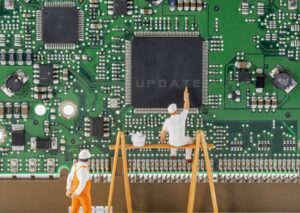How to Prevent Poor Solder Wetting?
2023-02-06Solder wetting defects generally means a kind of failure of the solder. The solder area of the circuit substrate (copper foil) or the external electrodes of the SMD to create a mutual reaction layer after wetting during the reflow soldering process, resulting in leakage or under-soldering.
By means of effective strategies, poor solder wetting can be prevented to ensure that your joints are durable.
What is solder wetting?
Solder technology is one of the oldest methods of permanently joining metals. Solder wetting is part of the process by which the metal in the solder is bonded to the metal on the printed circuit board (PCB) or component. During the wetting process, the solder becomes liquid and molten and adheres correctly to the component to obtain the best possible solder joint.
Wetting requires a copper surface that is free of contaminants and has reached the right temperature. Below, we will discuss why good solder wetting is essential.
Why good solder wetting is important?
Good solder wetting is essential for proper metal joining. Without it, the metal will not adhere correctly. Proper solder wetting will produce a good solder joint that will stand the test of time.
You can usually tell a good solder wetting by its appearance: a good solder wetting will be shiny and smooth with good flow. On the other hand, poor solder wetting is observable: its surface will look grainy, dull or porous and will result in poor adhesion to the component.
Causes of poor solder wetting
Poor solder wetting can be the result of a number of different problems.
- Oxidation of the solder surface
If the solder tip is kept hot without a cover, it can react with oxygen and lead to improper wetting.
- High or low soldering temperatures
Too high a temperature will cause the solder moisture to quickly turn into steam, too low a temperature and the solder will not flow as well as it needs to.
- Excessive holding of the soldering iron tip
Holding the tip of the soldering iron on the component for a long time can lead to flux burn and component damage.
- Insufficient wetting
Dirty boards or failure to heat the solder pads and pins can lead to insufficient wetting and poor bonding.
How to prevent poor solder wetting
- Preheat the soldering iron
Prevent cold soldering by properly preheating the soldering iron with the power required to reach the optimum temperature.
- Clean the surface
Clean any grease or dirt from the surface by wiping it with a common solvent.
- Use a highly reactive solder paste
Highly reactive solder pastes usually provide better wetting and help prevent poor wetting during reflow.
- Solder tips with solder
Adding solder to the hot end helps to prevent oxidation.
Contact KingPCB for the best PCBs
KingPCB has been specializing in the production and assembly of high-quality PCBs for over 15 years.
Contact us today if you have any questions. Or send emails to sales@kingpcb.com for latest quotation.




